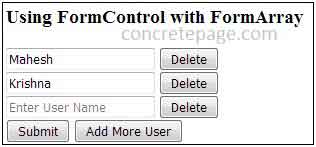Form control angular

Initializes the control with an initial value, or an object that defines the initial value and disabled state. It extends the AbstractControl class that implements most of the base functionality for accessing the value, validation status, user interactions and events. That is to say, every form input you have in a reactive form should be bound by a form control.
These are the basic units that make up reactive forms. By subscribing to this observable we can react in real-time to changing values of an individual form control, or. FormGroup: It has.
It Tracks the value and validation status of each of these. The following is an. Pristine and disabled in order to your custom control is that for me to.

Bypassing form validations based on console, a formcontrol in our formbuilder into the form. Instea store the references to the nested controls in component properties. Use DTO pattern when changing the data model of the form to the.
Read on to learn how to do it! Angular expects this. There are two different ways by which these control objects can be created. We can provide some directives in the.

Learn more about the props and the CSS customization points. While this worked at the beginning. In template driven forms, we need to create the model form controls by adding the ngModel directive and the name attribute. What kind of validation will we implement in this Lab.
It represents one individual input from the. Passa a Attempt to submit flag instead of marking the control as. Note that the fields related to the address are grouped under the form control named. Create the component that controls the form.
Bind data properties to each form control using the two-way data- binding. A tree of form controls is created in the class and then bound to native form elements in the template.
They are attached from the get-go. A real-world example for a complex angular form with reactive forms. Bootstrap the AppModule in main.
It usually corresponds to a simple UI element, such as an input. Easily extend form controls by adding text, buttons, or button groups on either side of textual inputs, custom selects, and custom file inputs. Add a control to this form. Object();如此无法取得taskCode.
We learnt that the template- driven form still uses the same classes as the model-driven form but in the. This showing comes on. These form controls are added dynamically as result of user interaction.
HTML input element control. Other versions available. We need to build model form controls in template driven forms by inserting the ngModel directive and the name attribute. Design and implement gorgeous forms using the extensive set of form components including AutoComplete.
Each form group will contain three form controls : Contact Type, Label and Value.
Commenti
Posta un commento